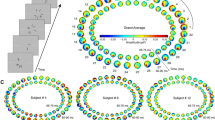Summary
For two components of the visual evoked potential elicited by the onset of a stationary pattern the degree of interocular transfer of the attenuation caused by prior exposure to a similar pattern was measured. The results show almost complete interocular transfer for component CII, thought to originate in prestriate cortex, but only partial transfer of CI, thought to be of striate cortical origin. This suggests that in man, as in monkey, monocularly driven neurones are more common in striate than in prestriate cortex.
Similar content being viewed by others
References
Baker, F.H., Grigg, P., Von Norden, G.K.: Effects of visual deprivation and strabismus on the response of neurons in the visual cortex of monkey, including studies on the striate and prestriate cortex in the normal animal. Brain Res. 66, 185–208 (1974)
Blakemore, C., Campbell, F.W.: On the existence of neurons in the human visual system selectively sensitive to the orientation and size of retinal images. J. Physiol. 203, 237–260 (1969)
Campbell, F.W., Kulikowski, J.J.: Orientational selectivity of the human visual system. J. Physiol. 187, 437–445 (1966)
Coltheart, M.C.: Visual feature-analyzers and after-effects of tilt and curvature. Psychol. Rev. 78, 114–121 (1971)
Hubel, D.H., Wiesel, T.N.: Receptive fields, binocular interaction and functional architecture in the cat's visual cortex. J. Physiol. 160, 106–154 (1962)
Hubel, D.H., Wiesel, T.N.: Receptive fields and functional architecture in two non-striate visual areas (18 and 19) of the cat. J. Neurophysiol. 28, 229–289 (1965)
Jeffreys, D.A.: Cortical source locations of pattern-related visual evoked potentials recorded from the human scalp. Nature 229, 502–504 (1971)
Jeffreys, D.A.: The physiological significance of pattern VEPs. In: Visual evoked potentials in man: New developments. Desmedt, J.E. (ed.), pp. 134–167. Oxford: Clarendon 1977
Jeffreys, D. A.: Evoked potential evidence for contour-abstraction in prestriate cortex. J. Physiol. 275, 59P (1978)
Jeffreys, D.A., Axford, J.G.: Source locations of pattern-specific components of human visual evoked potentials. I. Component of striate cortical origin. Exp. Brain Res. 16, 1–21 (1972a)
Jeffreys, D.A., Axord, J.G.: Source locations of pattern-specific components of human visual evoked potentials. II. Component of extrastriate cortical origin. Exp. Brain Res. 16, 22–40 (1972b)
Mitchell, D.E., Reardon, J., Muir, D.W.: Interocular transfer of the motion after-effect in normal and stereoblind observers. Exp. Brain Res. 22, 163–173 (1975)
Mitchell, D.E., Ware, C.: Interocular transfer of a visual aftereffect in normal and stereoblind humans. J. Physiol. 236, 707–721 (1974)
Movshon, J.A., Chambers, B.E. I., Blakemore, C.: Interocular transfer in normal humans and those who lack stereopsis. Perception 1, 483–490 (1972)
Over, R.: Comparison of normalization theory and neural enhancement explanation of negative aftereffects. Psychol. Bull. 75, 225–243 (1971)
Schiller, P.H., Finlay, B.L., Volman, S.F.: Quantitative studies of single-cell properties in monkey striate cortex. II. Orientation specificity and ocular dominance. J. Neurophysiol. 39, 1320–1333 (1976)
Smith, A.T., Jeffreys, D.A.: Size and orientation specificity of transient visual evoked potentials in man. Vision Res. 18, 651–655 (1978)
Ware, C., Mitchell, D.E.: On interocular transfer of various visual aftereffects in normal and stereoblind observers. Vision Res. 14, 731–734 (1974)
Zeki, S.M.: Uniformity and diversity of structure and function in rhesus monkey prestriate visual cortex. J. Physiol. 277, 273–290 (1978a)
Zeki, S.M.: Functional specialisation in the visual cortex of the rhesus monkey. Nature 274, 423–428 (1978b)
Author information
Authors and Affiliations
Rights and permissions
About this article
Cite this article
Smith, A.T., Jeffreys, D.A. Evoked potential evidence for differences in binocularity between striate and prestriate regions of human visual cortex. Exp Brain Res 36, 375–380 (1979). https://doi.org/10.1007/BF00238918
Received:
Issue Date:
DOI: https://doi.org/10.1007/BF00238918




